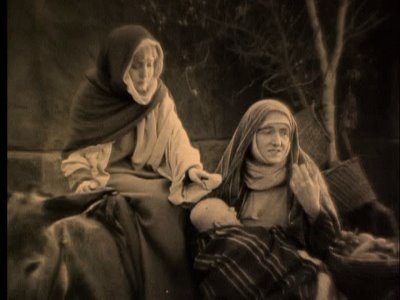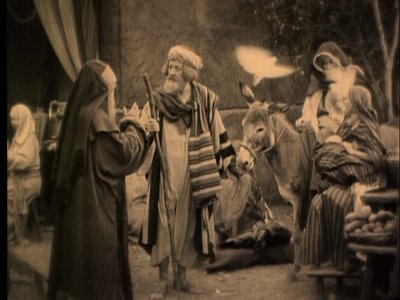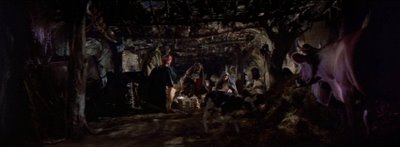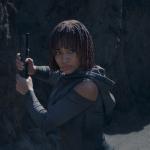Further to my earlier post on Mary in the movies, I would like to focus just a little on the depiction of Mary and Joseph in the two major film adaptations of Lew Wallace’s novel Ben-Hur. As always, click on the images below to see larger versions of them.
The 1925 version was made near the end of the silent era, and of its 143-minute running time, it devotes about 15 minutes to the Nativity. After the film establishes the Roman occupation and the Jewish yearning for a deliverer, these are the first images that we see of Mary and Joseph, as they arrive in Judea for the census:


Joseph and Mary arrive, and a man who recognizes Joseph greets him and asks who the woman riding behind him is.


Mary reveals her face, then reaches out to brush something — an insect, maybe? — from the head of a crying child.


The mother of that child defensively covers the baby and looks sternly at Mary, and Mary responds with a beatific smile.


The smile melts the woman’s heart, and then, as Mary and Joseph continue on their way, several doves fly about Mary’s head.
In a later scene, Joseph asks an innkeeper if there is any place for them to stay. Again, the innkeeper objects somewhat sternly, but he has a change of heart after gazing upon Mary’s face:
After this, the innkeeper takes Mary and Joseph to a cave, where he says David used to stay with his flocks many years before. Mary looks around, and her eyes light up when she sees the manger and touches it. “The place is sanctified,” she says. And then, of course, come the first images of her after the birth of Jesus:
There are a few things we could note about all this. The imagery is very much in the style of classic iconography, with doves and haloes and whatnot. And Mary actively does things — melting the hearts of stubborn people and declaring that the cave is “sanctified” — that signify her status as one who is “full of grace”.
Note also how much older Joseph is than Mary. In most movies, Mary and Joseph are close to each other in age, which — if the filmmakers in question bothered to think this far ahead — would have to mean that the “brothers” and “sisters” of Jesus that the gospels talk about are either the children of Mary and Joseph themselves (the dominant Protestant position) or the children of their relatives (the dominant Catholic position). But this may be the only major film which allows for the ancient tradition that Joseph was a widower, and that the “brothers” and “sisters” of Jesus were actually his step-siblings, i.e. the children of Joseph and his previous wife (the dominant Orthodox position).
Brief tangent: The 1925 version of Ben-Hur was a huge hit, and I suspect the fact that it already had a decent Nativity sequence may be one of the reasons why Cecil B. DeMille did not bother to include such a sequence in The King of Kings (1927), which he produced just two years later. But DeMille does give Mary a rather prominent role in the adult ministry of Jesus, and along the way, he uses some of the same motifs — notably the doves:
And now, on to the 1959 version of Ben-Hur. The first thing that strikes you about this film is how much briefer its Nativity sequence is; of the film’s 222-minute running time, only about 5 are devoted to the birth of Christ. And Mary, surprisingly, is not a very strong presence in this film; it is Joseph who has the more active role. Here are all the shots in which she appears:

This shot begins almost exactly at the point when the narrator, in setting up the Roman occupation and the Jewish yearning for a deliverer, uses the word “redeemer”. In this first shot, Mary’s face remains completely hidden from our view.

Mary is kept in the distance while Joseph talks to the Roman soldier who enumerates him as part of the census.

The Wise Men enter the stable and bow, as the camera turns to include Mary, Joseph and the baby Jesus in the shot.

After the Wise Men raise their heads, this is the point-of-view shot showing what they see. Mary and Joseph remain a bit distant, but note how Joseph’s face is lit while Mary’s is kept in shadow.

The Wise Men move closer to deposit their gifts, and one of them reaches out to touch the infant Jesus.

This is sort of a repeat of the previous shot, but notice the calf that leaps across the middle of the frame to come to its mother; whatever other function this calf might serve in the shot, it also happens to obscure Mary just that wee little bit more.
And that’s it. Mary is never seen again in this version of the story — though Joseph is seen again some 30 years later, in the scene below, as he explains to a neighbour in Nazareth that Jesus is truly doing “his Father’s work” even if he isn’t in the carpentry shop:
So, why does the 1959 film downplay Mary so much, compared to the 1925 film, almost to the point of eliminating her from the story? Two possibilities occur to me. It may be out of reverence, not unlike how both films always show the back of Jesus’ head but never show his face. But it may also reflect the 1959 film’s more secular, humanist sensibilities. Just as it is less interested in Jesus as messiah than in Jesus as pacifist — for more on this, see my review of the 4-disc DVD set — so too it doesn’t have much use for Mary beyond her obligatory appearance by the manger.























